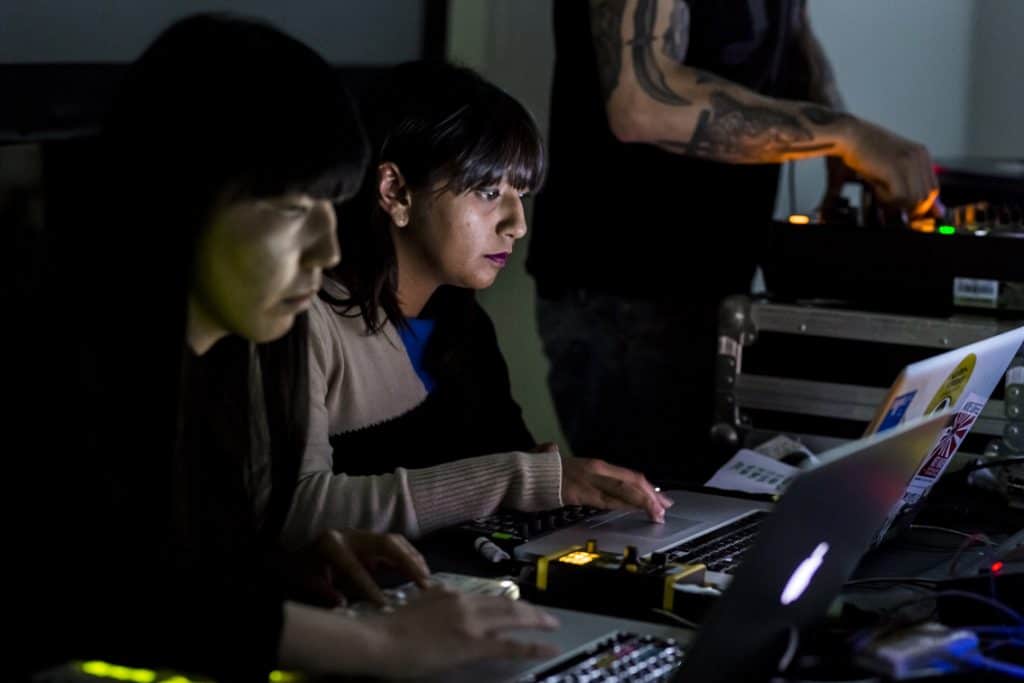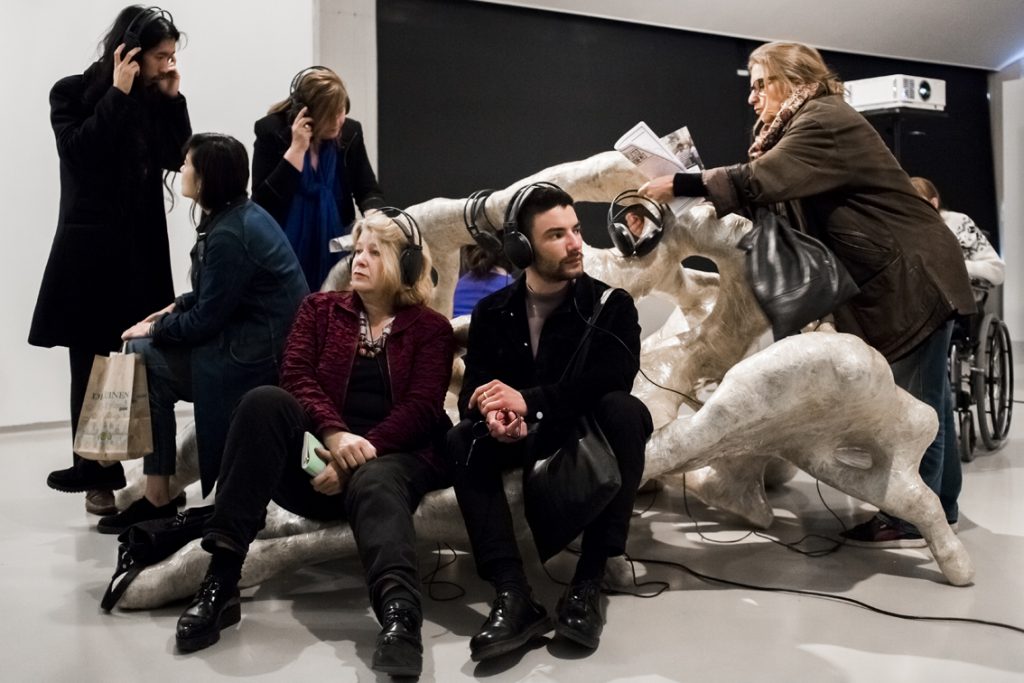An exhibition that focuses our view of migration and migrants, critiques our migration policies but does not fall into easy pamphleteering, that is 'Voices outside the echo chamber'.
Friday 29 April opened at the Tolhuistuin the exhibition "Voices outside the echo chamber"- an exhibition of Framer Framed, the Amsterdam-based organisation that has been questioning and commenting on the visual language in our arts for years. After all, in a globalising world, that visual language should also be allowed to globalise and not remain stuck in an almost endearingly Western narrative. Whereas Framer Framed - the name speaks volumes - was nomadic for years, since 2014 the organisation has settled in the Tolhuistuin for its exhibitions.
There, Framer Framed manages to create beautiful collaborations. Thus, the opening of this exhibition was not only a vernissage, but also the occasion for the live performance €urovisions programming, the opening film of the Image by Image 'host' festival, and connect with the Unprecedented Festival.
€urovisions
€urovisions is a live cinema performance, originated from a project of the European Cultural Foundation. That foundation initiated Doc Next Network, a network of young European media makers, often from a migrant background, to showcase stories of migration not found in mainstream media. This is done under the banner of 'Remapping Europe - a remix project' in which one principle is central: 'remapping media as a method to revise, re-examine and reconsider the dominant image of migrants in European societies.' Because, as the makers in the Remapping project argue, 'Migrants have entered European countries but they haven't entered the public sphere.'

From the database of short films this produced, four young vjs distill live performance of an hour, accompanied by a DJ. The three vjs sit behind laptops, the DJ behind a turntable and laptop, behind the foursome a screen. On that screen sometimes familiar images from last year's media (the drowned Aylan Kurdi), but much more often we are presented with fragments of an unseen world: a human smuggler telling us that he was a fisherman, but could no longer make a living from that, so he had to become a 'rais' on smugglers' boats; footage of migrants recounting how they prepare to travel in a hidden cargo space under cars; people telling how many people can hang under a truck; telling how they sometimes 'no longer feel human, but animals' and - also a recurring theme within the exhibition - how technology increasingly dehumanises them and reduces them to 'unwanted data'.
Not only at the EU's external borders (by now the deadliest border in the world, write Henk van Houtum and Leo Lucassen in their forthcoming book 'Beyond Fortress Europe') but also in shelters. This 'edit' of €urovisions shows a line that takes us from people's need to flee, through the various ways in which this happens, to the often indifferent or even hostile (there is a remarkably loud groan from the audience at the first time Wilders appears on screen) attitude that falls to migrants, to end with a couple of clips in which migrants wonder whether we, Western people, can be happy in the golden cage we have constructed for ourselves. A golden cage in which we live our lives, ignorant - or looking away - from the tragedies that also happen in our name. Because 'everything we see on television is staged,' a migrant tells us of our European life, having returned to his country of departure.
Voices outside the echo chamber
Then to the exhibition itself. It too starts from the premise that we do not realise enough what is being carried out in our name by bodies such as Frontex, what happens in refugee camps 'in the region' or how people cross the 'Mare Monstrum'. Fortunately, a lot of people do care about that - they are rightly outraged - but whether it necessarily produces good art is sometimes questionable. After all, anyone looking for figures or precise data can also consult the reports of 'The Migrant Files' to itself. Surely we demand that art not only be political, but that it can also touch us aesthetically, and evoke some ambivalence.
I myself always get a bit itchy when, in the introduction to an exhibition, I read sentences like "the dialectical relationship between the paradigms of human rights and borders forms the starting point of the exhibition", but fortunately the sentences underneath are in Dutch that is understandable to large parts of the visitors. What curator Katayoun Arian (Tehran, 1984) is doing with the exhibition Voices outside the echo chamber. Questioning myths, facts and framings of migration wants, the introduction still says, is to get us outside the 'echo chambers' [hints]the information bubbles we live in, which make it increasingly difficult to take in other opinions because we only follow like-minded people on social media, for example[/hints]. Outside those 'information bubbles', we would regain our sight of 'the complexity of human displacement and displacement.' Then we would no longer be stuck with our daily hobbyhorses on borders, migration and human rights. Come on, I thought, and walked into the room. In that space, a few artworks had been set out especially for the €urovisions opening show, so I did not see everything.

The first thing I did see was "Dictionary of Military Terms" by Maryam Monalisa Gharavi, which is of course a wonderful name for an artist. It is a video triptych in which the professional terms of the United States Department of Defense Dictionary of Military and Associated Terms are presented as an abc of 'empire' by contrasting them with modern means of war and the hand of the artist painting the letters. It was only when I saw the 'M' passing by again that I realised I had been looking closely at the entire alphabet. Fascinating how the actual force of war is never in military manuals, and always presented as neutral. Indeed, the comparison with our language on migration is obvious. Monalisa's second installation also plays with that contrast between guilt and innocence: in "Apparent Horizon II", that same American dictionary is contrasted with Monalisa's poetic translation of it.
Never returning pasts
After this, I could not watch the work "In-Formation" by Harun Farocki, because that screen was temporarily turned off. And so I walked on to the material infographic that Foundland made of a Syrian family's dining table. On that table, "Friday Table" we see a family tree, we see pictures of their togetherness, but above all we see how a family can be torn apart by war. While one was able to escape to Egypt to escape the war in Syria, another had to defect to Lebanon. Just as a cousin fled to Europe, a cousin migrated to the United States.
Whether they will ever all sit at the same table again? A second Foundland work also touches on the private sphere: for "Ground Plan Drawings", they asked refugees to draw the floor plan of the houses they had to leave. Here, too, the sense of a past lost forever intrudes.
Similarly, the work "ThE right tO RighT/WrOnG" a past. In this case, the past of December 1949, when the Universal Declaration of Human Rights had just been passed and a brake on what are now called human rights violations seemed imminent. Artists Libia Castro and Ólafur Ólafsson playing with that once-promised future and showing through their manifesto that those human rights have never been universal. Wouldn't it be better to acknowledge that?
The installation "IKNOWVERYWELLBUTNEVERTHELESS*" by Banu Cennetoglu was moved before the opening, as was the video "The Negotiation" by Kaya Behkalam & Azin Feizabadi had been turned off for a while. I will go back again to see the complete exhibition, although I could not find the list of "various people from four fundamental and intertwining scopes of the migratory control system" of Daniela Ortiz take home, just like the "ThE right tO RighT/WrOnG" paper.
If so, I will certainly enjoy the highly layered and brilliantly designed work "Conflicted Phonemes" by Lawrence Abu Hamdan one more time. Even after multiple viewings (it was already on show at Casco Projects in Utrecht), the mechanisms by which Somalis do or do not end up in asylum procedures based on their accent are incredibly fascinating. Once again, the supposed neutrality of our legal system turns out to be less neutral than it pretends to be.

That message, thankfully, is not thumbs-up, but sneaks up on you while viewing the works. Just when you have taken a seat in the audio sculpture "Bosbolobosco#6" and put on headphones, it hits you. The voice said, "I want you to feel safe, to think back to that safe place. Commit some time to reconnect to that place where you can relax a little." I can do that, but a lot of people around us can't. Because there are no more safe places to return to. That's not a happy thought, and certainly not the most common in my 'echo chamber'.
Yet the exhibition does not make you feel dejected, but rather makes you feel artsy and combative. Hopefully, that will also come across during the extensive fringe programming. Because exhibitions like this, we need them.
On view from 29 April to 3 June
Opening hours: Tuesday to Sunday, 14:00 - 22:00
Framer Framed (in the Tolhuistuin), IJpromenade 2, Amsterdam
